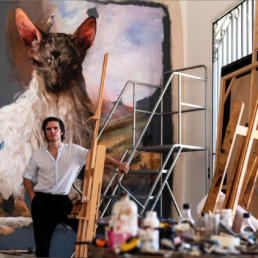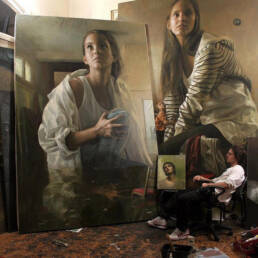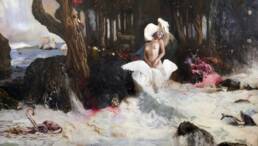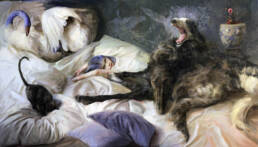Guillermo Lorca paints on an immense scale. Figuratively and metaphorically. Often described as ‘operatic,’ his paintings invoke visceral, powerful feelings in the viewer. Originally from Santiago, Chile, his work has exploded across the art world and he now commands a huge global following. We’re delighted (and a little humbled) to interview him here today.
The Birth of Venus (2021) 200 × 360 cm
The Girl in the Peacock Room (2017) oil on canvas 85 x 150 cm.
D: Hi Guillermo, very nice to meet you! We’ve been fans of your work for years, and it’s a privilege to get to talk to you and feature you on the platform. You’re in Barcelona right now. Are you living there or exhibiting?
GL: I have an exhibition at Moco Museum in Barcelona until November and It was a good excuse to spend a season in this city that I love. It’s a great place, sometimes a little crazy and that can be a problem ‘cause it’s difficult to concentrate!
D: Are you working out there – are you painting as well?
GL: Yeah, I’m painting here too.
D: So we’re here to talk about your work. You’re a prolific artist. Is there something in your life that inspired you, that made you want to create?
GL: Nothing really specific. It was something that started when I was a child. I used to enjoy drawing, to get inside my imagination, to lose myself. I have really good memories – like a happy place in my mind – when my mother used to paint when I was a kid, I saw her and I wanted to imitate her, take some brushes and try by myself. There were also many art books and even though I didn’t understand anything about art history I used to spend a lot of time seeing images and illustrations from books – I was obsessed with dinosaurs like many other kids – It was part of good memories of my childhood.
When I was a teenager I hung up the brushes for a while, to focus on another passion; Tennis. Eventually I quit (although I still do a lot of sport) And then I returned to drawing and painting. I started to have feelings that I could connect with something really deep inside of me, but it took me time and effort to project that in my artworks.
D: Was there an age when things suddenly started to work for you, when you said ‘wow! This is what I love!’
GL: When I was seventeen I decided that I wanted to study art and do this as a career. I was pretty young and decided to try it.
D: Were there any artists that particularly inspired you at the time?
GL: I think one of the first ones was Gustav Dore, the 19th Century illustrator. We had a book of fairy tales illustrated by him – I was completely in love with his work – I still am now – when I saw his works, they moved me to another period of history and I had the weird feeling that I’ve already lived in those places or situations.
D: Yes he’s an incredible blend of reality and fantasy. So, when you’re 17 or 18 you don’t necessarily have a lot of money for giant canvases. Where did you get the inspiration to paint on such a big scale?
GL: It started when I got one of my first jobs. I was asked to paint a mural at a vineyard in the north of Chile when I was 20 years old. It was a huge scale mural, 40 meters long by 4 meters high.
D: Wow, that must have been really exciting!
GL: It was! I had just started to paint and I had never painted something big in my life before. I was at the beginning of my career and, even though it was hard, I really enjoyed it. I also remember that when I was a kid I had a big canvas to paint on – about one meter long – which is big when you’re a kid! I think that’s where the fascination of big format started.
I also like the 1:1 relationship between the spectator and the characters on the canvas. Sometimes my compositions have many elements and the painting becomes large – it’s not that I necessarily want to paint everything big, it’s just that the composition makes the rules!


D: I know you’ve been asked this before but there are many levels to your paintings: there’s childlike innocence, and underneath there’s often fear, death, darkness. On one level there’s a fairy tale but on another there’s something much darker. Is that something you consciously set out to do or does it just evolve through the painting?
GL: It’s something more or less unconscious – the feeling that drives me to want to paint a subject I don’t have control over but during the composition I can realize different feelings or symbols. For some elements you can see tenderness or love or beauty but at the same time you have death or destruction. The first approach is unconscious but I try to get an harmony between those different forces.
D: Would you say that a lot of what you do is to challenge the viewer? Do you want the viewer to think and feel different things and to discover things in your work?
GL: Yes I do.
When you create some art work there’s a relationship with yourself. So there are things I paint because it’s important for me and that feeling, that moment is something you can’t translate exactly how it feels. But when I make a painting it’s not mine anymore, now it belongs to the public! So the people can interpret as they want, I just show possibilities. But I like that, the work is enriched with the different experiences it evokes and the different interpretations.
D: That’s really interesting – have you ever been surprised by people’s reactions? Have people come to you and said “this painting means this!” And you never thought that?
GL Yes! People have come to me and say ‘’that reminds me of that’ and I say “yeah could be!’ I mean i know what i paint and i have my own interpretation or i remember some of my feelings in the moment i created the paintings but sometimes i actually forgot why i painted that! After years you don’t remember! But that’s also something that I want. When a painting is open to interpretation it can touch you, deep inside of you. It’s like a horror movie – if you show the monster in the first scene then there’s no mystery! The fear or other feelings need to be created for the spectator.
D: One painting that struck me was La Curandera. It has such tension.
GL: I started painting that in the middle of the pandemic in 2020 and it was a kind of therapy. For me it represents hope, she is trying to relieve the gorilla’s pain but at the same time she is causing him another great pain. She’s using that suffering to get the cure. There are many things happening in the painting, it depends where you put your attention.
D: Have you thought about making films?
GL: Sometimes I’ve tried to imagine my paintings as a movie. When the paintings are together they can interact with each other and then create another kind of world. But it’s more like a dream where they’re connected symbolically but they don’t have a narrative structure. They’re more lyrical, more like a vision.
La Curandera (detail) (2020) oil on canvas 180 x 300 cm
D: On a different note, as we both know, the world is a fucking mess right now. One of the missions of Decadent is to expose as many people as possible to beautiful, different work, to bring hope to people in the chaos. Do you think art can help where we are?
GL: I think art can be a help for our ‘souls’ to try to find meaning in our behaviors, our circumstance, you can get to a place in your mind that’s incredibly beautiful and poetic. It’s something important but its not something that can save you from a bomb! I don’t think art can give you a solution but it’s a really powerful element to communicate ourselves and express our experience in this world.
D: Do you think that your art has got you closer to who you are inside?
GL: I think so. I don’t like to do art for another purpose than to find out what I have inside of me, a way to get along with my being .
Of course we live in a world with certain conditions and rules and I adapt to them in a good way. I do not reject the market at all, it is part of the deal. But when I create a work I am not thinking about how the market is going to react, in fact I have no way of guessing it if I wanted to. Therefore I focus only on what I like and feel proud of what I did.
D: Yeah, if you’re just doing it for the money it’s never going to be great. So I’ve one last question. We’re called Decadent because Decadent can mean decay but it can mean the point that rebirth happens. There was an arts group in the 19th century…
GL: Yeah yeah, I know!
D: Ah! So…what does decadent mean to you?
GL: It’s the moment when something that’s not working anymore breaks down and you get a kind of craziness because you lost something you had before. But in the middle of decadence is the moment when new things are created. Eventually the new thing’s going to take the power but in the beginning it is a kind of crazy change!
D: Haha exactly. Thanks so much for talking with us today. It’s been an absolute pleasure.
Instagram here
Website here

The Landing (2019) oil on canvas 140 x 110 cm




